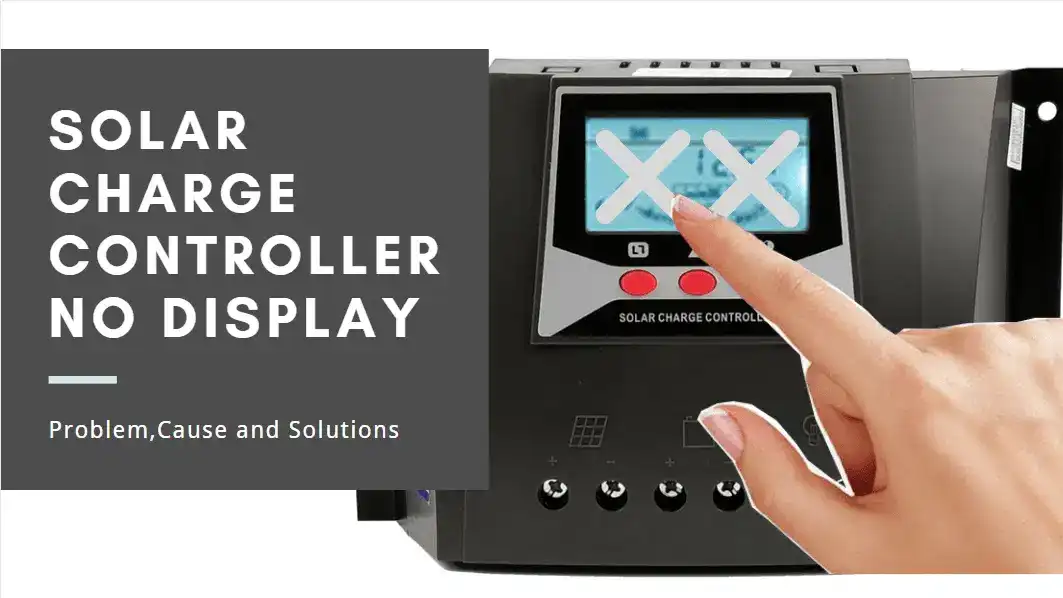Has your Solar Charge Controller Display gone blank? Does the screen turn on momentarily only for it to turn off again? Don’t fret.
Your Solar Charge Controller is a small but important device.
Without it, you wouldn’t be able to make your solar power system run, or program your Load settings to your liking.
So what do you do when your solar charge controller display not working?
Here are four easy ways you can troubleshoot this issue and restore your home’s power fast.
4 Reasons Your Solar Charge Controller No Display and How to Fix It
The Display Lines is broken and Need to be Replaced
If your solar controller screen is blank, the first thing you should do is check the Screen Lines. Chances are, the lines have disconnected and the dispplay simply can’t power on. Reconnect or Replace the line and see if your display turns on. If not, proceed to the next step.
No solar power input
Typically, solar charge controller are connected to a solar panel or solar battery via the cables. Sometimes, if there detect no solar energy input, the display will died as well.
If you’ve checked the solar input already, check the solar breaker. If it the breaker has tripped, simply flip the switch back on and check if this restores the solar charge screen.
Temperature extremes can also cause display malfunctions in solar charge controllers. If your controller is installed in an unventilated enclosure or equipment room, excessive heat may trigger automatic display shutdown to protect internal components. For installations in confined spaces, consider adding wall mounted air conditioner units to maintain stable ambient temperatures. Wall-mounted ductless systems are ideal for tight equipment rooms where floor space is limited, ensuring your charge controller display operates reliably while preventing heat-related shutdowns that mimic power input failures.
Drained Battery
The power for the solar controller display screen is actually provided by a solar battery, and usually it will only light up if it is connected to a battery, and if there is power inside this battery. The solar controller will not have a built-in battery because is simply not needed.
A battery without a discharge protection device, or continuously discharged to depletion, can lead to the inability to power the display. At this point, you can change a battery to test or charge the battery first.
Your Solar Charge Controller is Dead
Worst case scenario, your solar charge controller is at the end of its life and simply needs to be replaced. While all solar controllers are different, the average device has a life expectancy of about 7 years.
Give your local Solar energy professionals a call — they will advise you on whether or not your solar charge controller needs to be replaced.
The use of the solar controller display is very important and is needed when setting charging parameters, viewing error codes, setting load parameters, viewing real-time status, and viewing power data.
Almost all solar controllers come with an LCD Display, whether it is a mppt type controller or a PWM type controller, all need to use the LCD screen to assist in control.
If you have a solar charge controller that’s not displaying the information you expect, it’s probably because your charging system isn’t working correctly. To fix this problem, you can try to reset the charge controller, which can be accomplished by pressing the power button and reset buttons together. If your display is still not working, you can try to change the polarity of the panels. Switching the leads can help.
If your solar controller displays a moon symbol, it’s because it’s not receiving voltage from the panels. To check this, referring to the charge controller troubleshooting and disconnect the solar panels and try again. The controller should display a voltage of at least 18V, but the actual number will depend on the solar panels’ rating and how much sunlight they receive. If the controller is showing a voltage lower than that, the problem is likely with the solar panel, but it can also be due to a connection issue.
If you’ve tried everything and your solar charge controller still shows a red fault code, the cause may be a faulty battery or a miswired battery. In the latter case, it’s worth contacting the manufacturer of your solar charge controller. They’ll be able to help you resolve this issue. If you can’t find any of the three issues, the next best thing to do is contact ZHCSolar Technical Support.
For persistent display issues in solar charge controllers, environmental factors like improper roof installation can contribute to moisture infiltration affecting electronics. When mounting solar equipment on buildings, proper weatherproofing is essential. Using quality materials like certainteed synthetic underlayment beneath your solar array mounting structure provides superior moisture barrier protection, preventing water damage that could affect charge controller displays and other sensitive electronics in your solar power system, particularly important in regions with heavy rainfall or snow.

